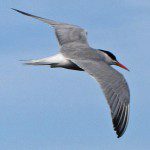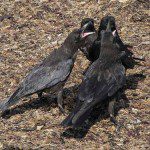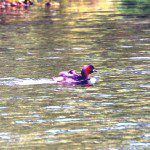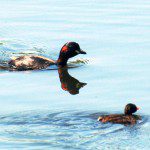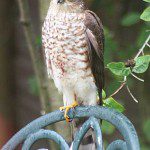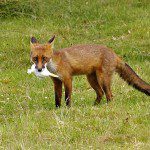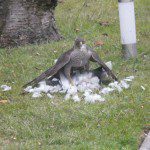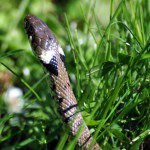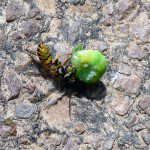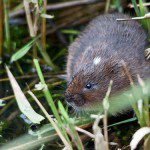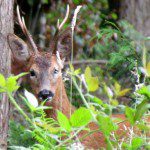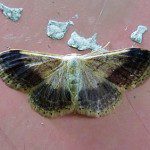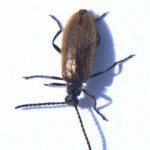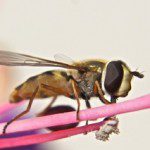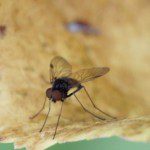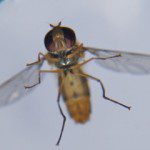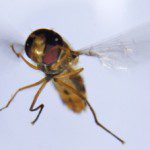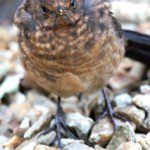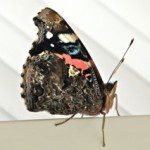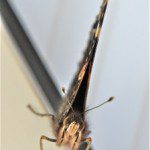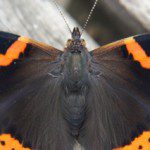We may be seeing broadleaf trees coming to the nature reserve in the future. Dave has recently applied to the Forestry Commission to plant 1 hectare of broadleaved woodland in a field adjoining the current nature area. Watch this space!
Whitethroat, Mediterranean Gull, Little Grebe | Axe Estuary Birds 161
[Axe Estuary Birds is republished with permission and sincere thanks to the team! Apologies — due to technical limitations it has not been possible to preserve the layout of the print version of the newsletter on this occasion. See gallery at the bottom of the post.]
The Birds
This Whitethroat was just next to Seaton Marshes Hide on July 15th, photographed by Ron McBride, a visitor from Coventry.
The gulls on the right, snapped by Roger Boswell, clearly show the difference between a Black-headed Gull and the Mediterranean Gull behind with its blacker hood extending down the nape of the neck.
Talking of Gulls, David Janaway spotted two ringed Herring Gulls at Coronation Corner on Monday 18th July – one had been ringed at West Hatch Wildlife Centre on 17th July 2009, when taken in with a damaged left wing, and released on 10th September of that year, and the other ringed at Gloucester Landfill Site on 18th July 2010. It is interesting to speculate on what motivated them to come here!
On Monmouth Beach at Lyme Regis, Roger Boswell came across this Parliament of Crows, clearly putting the world to rights, and this Sandwich Tern fishing off the Cobb.
Ian Waite reports a Little Grebe on the Borrow Pit with chick, and Sue Smith got these pictures.
The Trivia
Nature Red in Beak and Claw! Some rather gory images this time, Geoff Morris captured a Sparrow Hawk in the act, and Mike Dannat another rather replete one in his garden. And on 15th July Ron McBride from Coventry saw this Fox with a gull’s head in its mouth, just near the lagoon at Seaton Marshes. I was there too, and we watched the fox devouring the gull, and eventually he trotted off with the head, and came back a few minutes later. I can’t help wondering how the fox managed to catch a gull! Peter Vernon saw a Wasp attacking a caterpillar the other day on a road near where he lives He didn’t wait to see the wasp carry off the his prey but reckons he must have struggled getting it airborne! Susan Smith snapped this Grass Snake at the Borrow Pit – a real snake in the grass!
And to counteract the gore, another lovely picture of a Water Vole at BHM, taken by Roger Boswell.
A few days ago I saw something I had never seen before – an adult Shelduck chasing of a female Mallard, what had the poor Mallard done to annoy the Shelduck, I wonder?
Colyford Common Snippets
There has been much to see at Colyford Common over the last two weeks – too much to list it all in this newsletter! There have been at least eleven species of Wader recorded in the period. The scrape is attractive to Wildfowl, Herons and Gulls. It is the beginning of the autumn migration for the birds, who are slowly returning to their winter feeding grounds. A Montagu’s Harrier was reported on 17th.
News from Holyford Woods
I started seriously studying ‘our’ Roe Deer five years ago, with the help of Richard Prior’s detailed book on Roe. At that time there was a very laid-back buck in residence. I saw him so often he became very used to me, and Paco, and I have written of him, and sightings of does, occasionally with fawns, in the Woods.
At present the current buck is very active, in the rut. Paco has spotted him three times, twice ‘fraying’ (scent-marking) the trunks of conifers. I have also discovered he has been doing so on an oak tree, a few yards below my seat. Most interesting of all, on the level ground at the West end of the path below The Hangings, is the discovery of where the buck has been fraying small saplings, scraping back the undergrowth to expose the garlic bulbs, and ring-running – chasing a doe in circles around clumps of ferns and possibly mating. This has been going on for nearly 2 weeks. During that time I have regularly seen deer on the hillside above, and one morning Paco got very excited when we heard a prolonged session of a deer barking there. Paco’s recent disturbance of a fawn indicates there are at least 2 around, as they usually have twins. Sadly, following the bitter cold winter 3 deer have been lost. Definitely two of those were female. I hope we will soon have fresh ones taking up residence, as there are plenty of Roe deer in the woods and fields north of Holyford. Photo of buck by Jean Kreiseler: “The buck, beside the tree he was fraying.”
Jean is away in Botswana on another wonderful wildlife holiday, we hope to hear from her on her return.
Ringing
Despite an early start again fewer birds were present, but we did catch 42 of 13 species. These were: Blue Tit 6; Great Tit 4; Reed Warbler 12 (2); Sedge Warbler 7; Kingfisher 2 (1); Wren 1; Dunnock 2 (1); Blackcap 1; Greenfinch 1; Mallard 2; Chiffchaff 2; Blackbird 1; and Reed Bunting 1. Interestingly, the majority of Reed and Sedge Warblers were juveniles, suggesting that adults had moved on from their local breeding site in the reed beds. Juveniles usually follow later. It will be interesting to see what is caught in the next session which is three day operation from Friday to Sunday 12-14 August. Further details nearer the time.
This photograph of a Riband Wave moth Adult, aberrant dark Form, was taken by Peter Vernon and made it onto the ukmoths web site.
http://ukmoths.org.uk/show.php?id=6283
Diary Dates
Apologies for no details this time – after cataract surgery I cannot see clealy. Suffice to say there are at least 31 events during August, and if you need to know more please contact the EDDC Countryside Service on 01395 517557 and ask them for a copy of the event guide.
This twice-monthly email newsletter is freely available to anyone who would like it, as is a periodic one about the activities of the East Devon Local Group of the Devon Wildlife Trust. Just send me an email with Axe Estuary Birds and/or East Devon DWT in the subject line. Also, for those without a computer, I will send a copy by post if you would like to send me some stamps.
Thanks to those who keep me informed. Please continue to tell me of any unusual, interesting or amusing sightings, and what is about locally, and send any photos you would like to share.
Mike, Jean, Bob and David. (and many others!) davidwalters@eclipse.co.uk. tel. 01297 552616 Mobile 0779 1541 744.
More great nature photos from Keith West
Thanks to Keith again for these close-up photos of a hoverfly, red admiral butterfly, and young blackbird.
He says “Not great weather for birds at present but a good opportunity to get close
to some of the insects around the area!”
All photos copyright Keith West.
Oyster Catcher, Water Rail, Little Grebes: Axe Estuary Birds #160
Reprinted here with permission and sincere thanks to the team!
Axe Estuary Birds No 160 July 15th 2011
The Birds
 On July 11th, an Oyster Catcher chick emerged at Black Hole Marsh. We think that the parents are those whose first attempt was frustrated by marauding gulls some weeks ago, and it’s great that they have succeeded this time. Well camouflaged in the rock, but visible. Photo Sue Smith
On July 11th, an Oyster Catcher chick emerged at Black Hole Marsh. We think that the parents are those whose first attempt was frustrated by marauding gulls some weeks ago, and it’s great that they have succeeded this time. Well camouflaged in the rock, but visible. Photo Sue Smith
 From the Tower Hide, near the mouth of Stafford Brook, at the end of June Ian Waite saw a young Water Rail with an adult, and also three Water Voles. Then on July 1st he saw fairly well grown young Little Grebes on the Lagoon at Seaton Marshes. There was a nest on the Borrow Pit, but whether these were from that nest or another he is not sure.
From the Tower Hide, near the mouth of Stafford Brook, at the end of June Ian Waite saw a young Water Rail with an adult, and also three Water Voles. Then on July 1st he saw fairly well grown young Little Grebes on the Lagoon at Seaton Marshes. There was a nest on the Borrow Pit, but whether these were from that nest or another he is not sure.
On July 4th, Ian saw no less than 6 Common Sandpipers from the Tower Hide, and Carol Lowe sent this lovely photo of a Water Vole.
Then this week Ian saw 15 Dunlin and four Little Ringed Plover on Colyford Scrape, and three Greenshank, 12 Common Sandpiper, one Green Sandpiper and 12 Black-tailed Godwit from the Tower Hide at BHM.
 Steve Waite reports a remarkable 22 Bullfinches of various ages in his Seaton garden, which makes me wonder if the two or three frequently seen by the rest of us are part of a much larger flock.
Steve Waite reports a remarkable 22 Bullfinches of various ages in his Seaton garden, which makes me wonder if the two or three frequently seen by the rest of us are part of a much larger flock.
Steve Waite going to a ringing session :- “A scan over Blackhole Marsh on way to the rendezvous point revealed our first Little Ringed Plover of the ‘autumn’, an adult… There were a few other waders about too; my first autumn Green Sandpiper on the southern end of Colyford Marsh, eight Common Sands on the Estuary and at least six Blackwits still on the Estuary. Oh, that reminds me, about four weeks ago the group caught a pair of Lesser Whitethroats on Colyford Common – both adults and the female with a brood with a brood patch. In the hedgerows there were a few Willow Warblers and a Whitethroat – I haven’t seen either of these species here since the spring so I presume these were returning migrants? And a Herring Gull nearly did me a serious injury !”
 “Look at me !!” A very proud Robin in Simon Wakely’s garden at Whitford.
“Look at me !!” A very proud Robin in Simon Wakely’s garden at Whitford.
Mike Lock reports “Today (12th) I went down to Black Hole Marsh for the first time for about four weeks – have been on holiday in Scotland . The highlight was three adult Mediterranean Gulls with full black hoods, accompanied by what I think was a juvenile. Also about 200 Black-headed Gulls, mostly with full chocolate hoods. Two Great Black-Backs on the estuary and a single Little Egret and single Heron. Also at least two Common Sandpipers, three Dunlin, and ten Black-tailed Godwits. The Oystercatchers have a single very young chick – how long will it last? The Mallard are still hatching; one female near the Tower Hide had two young no more than a day or two old, and another brood of ten on the ‘Green Patch’ were no more than a week old. The Shelduck broods are coming on nicely – one of ten and another too far off to count.
I saw a young Little Owl in Musbury last week. The adults are also around and often calling both by day and night. Our garden birds were not fed for three weeks while we were away. Some (Blue Tit, Great Tit, Chaffinch, Robin) returned within a day of feeding restarting; Goldfinches and a Dunnock returned after three days, and Greenfinches, House Sparrows and a Great Spotted Woodpecker took over a week to return. The House Sparrows live fifty yards up the road but clearly do not move about much!”
Ringing
Just to let you know we had a very good catch yesterday, the 9th, thanks to Ian and those ‘early birds’ who gave up their sleep to attend at 5.00am. Well done chaps, but now you have created a precedent!
The catch comprised of 91 birds as follows: Blackbird 4; Blackcap 4; Great Tit 3; Dunnock 3 (1); Blue Tit 16 (3); Sedge Warbler 7 (1); Reed Warbler 25 (8); Song Thrush 3; Reed Bunting 9 (1); Wren 2; Greenfinch 8; Linnet 2; Starling 2; Chaffinch 1; and Goldfinch 2.
News from Holyford Woods
 Walking the paths through the trees one cannot see much as everything is overgrown and tangled. However along The Hangings there is much to enjoy in spite of the bracken and brambles which have gone mad this year. On many of my recent visits I have had my pruners in hand, cutting back the strong arching shoots which will reach the track and root themselves. Paco does not like being asked to ‘wait’ constantly and is glad to get back into the Woods. The track is lined with dainty grasses, ranging from a sandy colour to pink to warm maroon, interspersed with clumps of elegant arching Pendulous Sedge. The amount of Blackberry flowers indicates there will be lots for pies and crumbles. Butterflies are still almost non-existent, though here on the hillside on a warm and muggy morning I counted 25+ Meadow Brown, and 1 White too swift to identify. I wonder if it is true, as it is suggested, they are suffering from a similar disease to that which is killing Bees?
Walking the paths through the trees one cannot see much as everything is overgrown and tangled. However along The Hangings there is much to enjoy in spite of the bracken and brambles which have gone mad this year. On many of my recent visits I have had my pruners in hand, cutting back the strong arching shoots which will reach the track and root themselves. Paco does not like being asked to ‘wait’ constantly and is glad to get back into the Woods. The track is lined with dainty grasses, ranging from a sandy colour to pink to warm maroon, interspersed with clumps of elegant arching Pendulous Sedge. The amount of Blackberry flowers indicates there will be lots for pies and crumbles. Butterflies are still almost non-existent, though here on the hillside on a warm and muggy morning I counted 25+ Meadow Brown, and 1 White too swift to identify. I wonder if it is true, as it is suggested, they are suffering from a similar disease to that which is killing Bees?
I have only seen 1 large Hornet, supping from a run of sap in a hollow on an oak tree. Very early one morning walking down the field to the main entrance I counted 35+ Rabbits before they shot into the undergrowth. Plentiful food for Buzzards, but I have only occasionally heard the plaintive call of 1 young one. Walking along several of the paths one is crunching on snail shells around stone ‘anvils’ still in use by the Thrushes. Bird song has died down now, there are mostly the calls of Chifchaff, Greater Spotted and Green Woodpeckers, Nuthatch, and Corvids to hear.
I have had lovely views of the buck lately and the one this morning was really good, as he was fraying the trunk of a conifer. Then later, along The Hangings track, Paco disturbed a fawn. The first this year for me. Jean Kreiseler
Jean feels that newsletter readers have only ever seen Paco’s rear end, so sent this picture!
The Trivia
Be part of the Big Butterfly Count from 16 to 31 July this year and help save them.
This is the link to Butterfly Conservation to record your butterflies http://www.bigbutterflycount.org/
Next week, 24th to 29th July is East Devon’s Heath Week, with lots of events for the whole family. Find out more at
http://www.devonwildlifetrust.org/i/Heath_Week_events_2011.pdf
The Love story continues ! “We were sitting in the conservatory and chatting about this and that when friend Alan remarked that he hadn’t seen ‘those Lovebirds‘ yet – we could hear their distinctive calls and, as he sat there, watching through the door, my eyes were drawn to the large brown bird which flew up from behind the Acers close to the windows. Almost before I had time to say anything, it reappeared and perched atop the highest level of the bird feeding station, no more than 5’ from the glass. Alan turned round slowly to see it and we were all able to view this female Sparrowhawk close up for a minute or so before it flew off. I think that for all of us this was our closest ever encounter with the species.
Oh, yes, he saw the Lovebird, too !” Mike Dannat
Diary Dates
Sunday July 17th 2.30 pm – 4.30pm Winefred Walk A guided walk to take in the key sites in the
Winefred Story. Led by Donald Campbell, meet Windsor Gardens
Seaton. (Opposite Town Hall)
Sunday July 24th – Friday July 29th July East Devon’s Heath Week – see link above.
Thursday July 28th 9.00 am – 10.am Birds from the Tram for youngsters, led by James Chubb. Please
book with Seaton Tramway on 01297 20375.
This twice-monthly email newsletter is freely available to anyone who would like it, as is a periodic one about the activities of the East Devon Local Group of the Devon Wildlife Trust. Just send me an email with Axe Estuary Birds and/or East Devon DWT in the subject line. Also, for those without a computer, I will send a copy by post if you would like to send me some stamps.
Thanks to those who keep me informed. Please continue to tell me of any unusual, interesting or amusing sightings, and what is about locally, and send any photos you would like to share.
Mike, Jean, and David. (and many others!) davidwalters@eclipse.co.uk. tel. 01297 552616 Mobile 0779 1541 744.
Axe Estuary Birds 159: Cuckoo!
Axe Estuary Birds No 159 June 30th 2011
The Sky over Whitford, Saturday 18th June – Simon Wakely
The Birds

 Steve Waite writes ;- “I hadn’t seen or heard a Cuckoo on patch for at least seven years – and have only heard/seen three ever. So as I was driving between Southleigh and Colyton, I came to a sudden halt when I saw a Cuckoo perched right besides the road! Unfortunately, the stopping of my car made it take to the air. A couple of Swallows chased it as it flew towards a near by wood, but it U-turned and flew back low over the road – heading for a large Oak tree.”
Steve Waite writes ;- “I hadn’t seen or heard a Cuckoo on patch for at least seven years – and have only heard/seen three ever. So as I was driving between Southleigh and Colyton, I came to a sudden halt when I saw a Cuckoo perched right besides the road! Unfortunately, the stopping of my car made it take to the air. A couple of Swallows chased it as it flew towards a near by wood, but it U-turned and flew back low over the road – heading for a large Oak tree.”
Recent photos by Steve – a Mistle Thrush with hungry mouths to feed, and three Little Egrets.
A Hobby was seen by Ian Maclean over Colyford Common on 29th, and on the same day there were approx 40 House Martins at Black Hole Marsh. The Reed Warblers and Reed Buntings can still be heard there, but seldom seen!
Images from Black Hole Marsh –Young Shelduck and two young Sedge Warblers, and one from Colyton – a Spotted Flycatcher all by Susan Smith.
The Trivia
Peter Mason tells me there are Pyramid Orchids on the Seaton Hole to Beer Cliff path.
Maggie Dilley asks “Did anyone else notice how “happy” the birds seemed to be after that rainy Sunday’? Our bird feeders were busy all day with many birds and many young – Blue Tit, Goldfinch, Greenfinch, Nuthatch, Woodpecker, and even a young Bullfinch (had to look that one up in the book!). We also had a Mistle Thrush that sang all day from most of the tall trees in the garden. A bit after the event but we have been putting apples out again for the Blackbirds which they seem to appreciate.”
The Water Voles have been showing well near the Tower Hide recently. Sue Smith saw six, and managed two lovely photos, and even I saw one on the 29th! And on the next day a Stoat showed as well. For good measure, a Fox Cub also joined the party.
A Lens Cap for a Sony camera has been found, and is currently in a locked notice board at Black Hole Marsh Island hide. Please contact me on 01297 552616 if you have lost one.
The Log Books at Colyford Common and Seaton Marshes, seldom used and sometimes defaced, have been removed, so please tell me if you see anything of interest there.
Ringing
Another excellent catch on 23rd June of 60 birds with some interesting retraps, including a House Martin the Group ringed in 2009. The tally was:
Reed Warbler 23 (11); Kingfisher 2; Blue Tit 4 (1); Great Tit 5; Goldfinch 3; Treecreeper 1; Sedge Warbler 6 (2); Greenfinch 2; Mallard 1; Swallow 2; House Martin (1); Blackbird (2); Chiffchaff 6; Wren 1; Blackcap 1.
News from Holyford Woods
The rampant undergrowth invading the paths would have soon meant wet legs and nettle stings, but thanks to Dave Palmer, our Countryside Ranger, they have all been cut back. He is also called in to clear the paths of fallen trees and limbs after storms, and helps with keeping open the glades that have been created. The rabbit numbers are well up this year, so I am very surprised that there are as yet no young Buzzards calling in or over Seaton Down Coppice. It is a long time since I have seen any Long Tailed Tits but there are 4 Chiffchaffs calling loudly and 3 Blackcaps singing in their territories. Bird numbers are generally down, and we cannot blame the squirrels as I have only seen one over the last month. I think two bitter snowy winters can be blamed for the low number of feisty little Wrens. Checking in the fields along the North side of the Woods, I have seen 2 Mistle Thrush, and 1 Green Woodpecker though I have been told 2 young Green Woodpeckers were seen recently near the bridleway. This morning Paco disturbed a hen Blackbird feeding 2 juveniles on the way to my seat. Also the peace of the Woods was shattered with a group of children from Seaton Primary School learning about the different types and texture of tree bark. They were very happy to be out of the classroom. I spoke to one boy who said his parents often bring him and his sister to Holyford which is good to know.
Because I am worried about the fewer numbers, I have recently made a donation to the Corvid Research Project Appeal for Songbird Survival.
This is their address for donations on line:-
Note:- Last week I was travelling from the 3052 to Axmouth when I spotted a Red Kite being hassled by a Buzzard. By the time I could park, and get my bins out, they had flown East towards the North side of Hawkesdown Hill. They are such a wonderful sight, and hopefully we will have them breeding here. Jean Kreiseler
This twice-monthly email newsletter is freely available to anyone who would like it, as is a periodic one about the activities of the East Devon Local Group of the Devon Wildlife Trust. Just send me an email with Axe Estuary Birds and/or East Devon DWT in the subject line. Also, for those without a computer, I will send a copy by post if you would like to send me some stamps.
Thanks to those who keep me informed. Please continue to tell me of any unusual, interesting or amusing sightings, and what is about locally, and send any photos you would like to share.
Mike, Jean, and David. (and many others!) davidwalters@eclipse.co.uk. tel. 01297 552616 Mobile 0779 1541 744.
Up Tails All – Photo Carol Lowe



